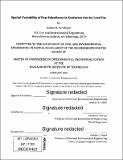Spatial variability of peat subsidence in Southeast Asia by land use
Author(s)
VanHemel, Amber R.
Download1281670868-MIT.pdf (13.95Mb)
Other Contributors
Massachusetts Institute of Technology. Department of Civil and Environmental Engineering.
Advisor
Charles F. Harvey.
Terms of use
Metadata
Show full item recordAbstract
Variograms are a valuable tool for geospatial analysis as they provide a description of how data are correlated as a function of separation distance. Their application can prove valuable for not only analyzing variations in environmental parameters such as peat subsidence in two dimensional space, but also to understand the factors governing these variations. With the deforestation and drainage of wetlands in Southeast Asia, there has been a gradual sinking across large areas of land (i.e. subsidence). Exposed carbon-rich peat oxidizes and subsequently subsides, emitting carbon dioxide into the atmosphere. Interferometric Synthetic Aperture Radar (InSAR) satellite data coupled with geostatistical analysis have been used to obtain key information on how subsidence varies at a fine spatial resolution. This project used gridded datasets from 8 sites across Indonesia and Malaysia to quantify the variance and spatial continuity of subsidence by land use type at a short spatial scale (1 kilometer). Subsidence rates in smallholder area and moderately degraded peatswamp forest were found to be autocorrelated within a few hundred meters, ranges of 270 ± 30 m and 230 m ± 40 m, respectively.
Description
Thesis: M. Eng. in Environmental Engineering Science, Massachusetts Institute of Technology, Department of Civil and Environmental Engineering, September, February, 2020 "February 2020." Manuscript. Includes bibliographical references (pages 32-33).
Date issued
2020Department
Massachusetts Institute of Technology. Department of Civil and Environmental EngineeringPublisher
Massachusetts Institute of Technology
Keywords
Civil and Environmental Engineering.